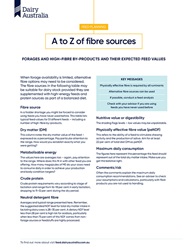Facts on Alternative Fibre Sources
Fibre is an essential ingredient in the diets of ruminant animals such as cattle. It is the structural carbohydrate component of plants which keeps plants upright. Fibre is found in the plant cell wall. There are three main parts – hemicellulose, cellulose and lignin.
A key role of fibre in cattle is to promote chewing, so feeds with fibre length greater than 1.5 centimetres, but not longer than the width of the mouth, are preferable as they take longer to chew.
Lush, actively growing pasture is high in sugars. More leaf than stem means less fibre. Grain is plant seed material and not structural plant material – it has high levels of starch, not fibre.
More information about fibre is available in Dairy Australia Facts about fibre fact sheet.
Ruminal Acidosis Risk Assessment fact sheet
Alternative fibre sources
Many alternative fibre sources can be fed to dairy cows if they are supplemented with high-energy feeds and protein sources as part of a balanced diet.
Nutritional values of high-fibre by-products are particularly variable. Dairy farmers should analyse the results of a feed analysis test before buying alternative fibre sources.
When pasture is limited and supplies of fodder are reduced, farmers may be forced to consider using alternative fibre options which they may not have used before.
These fibre options vary widely in nutritive value, digestibility and effective fibre value. They may present risks such as rumen acidosis, mycotoxins and chemical residues, so it is important to be cautious.
Some alternative fibre sources which may be available depending on seasonal circumstances and location include:
- Almond hulls
- Palm kernel meal
- Cereal straw (barley, oats, triticale, wheat and rice straw)
- Sugar cane
- Grape marc
Dairy Australia's Alternative fibre sources fact sheet provides nutritional information and management tips on alternative fibre sources. If in doubt, seek professional advise to ensure that right decision is made for each individual situation.
A–Z of fibre sources
When forage availability is limited, alternative fibre options may need to be considered. The fibre sources may be suitable for dairy stock, provided they are supplemented with high-energy feeds and protein sources as part of a balanced diet.
Dairy Australia's A–Z of fibre sources fact sheet lists typical feed values for 51 different feeds, including a number of high-fibre by-products and their expected feed values across:
- Dry matter
- Metabolisable energy
- Crude protein
- Neutral detergent fibre
- Nutritive value or digestibility
- Physically effective fibre value
- Maximum daily consumption
A to Z of fibre sources
It is important to get the balance right. Farmers should seek professional advise to check their assumptions, calculations and maximum daily consumption rate are adequate for their cows.





